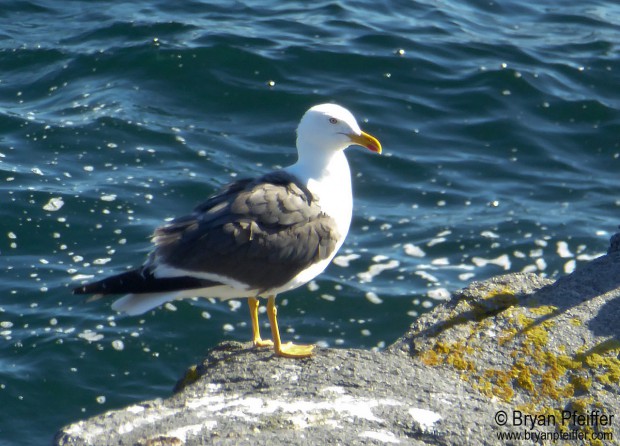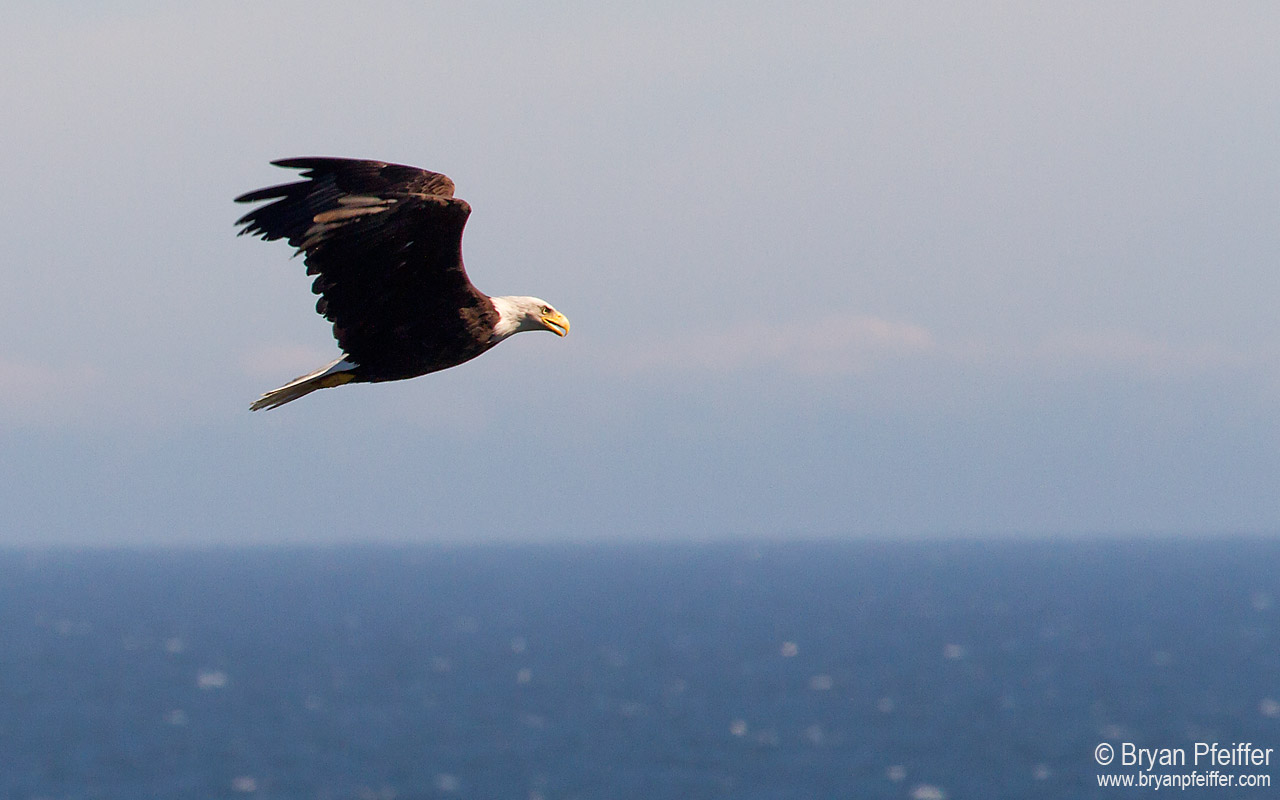Monhegan Migration Report No. 3: The Usual Oddities
THE USUAL RARE BIRDS HAVE ARRIVED. Yeah, it’s an oxymoron. How can rare birds be usual? Well, this is Monhegan Island, after all, where oddities (avian and human) are commodities.

Lesser Black-backed Gull near Gull Rock on Tuesday (from a distance with my little point-and-shoot) / © Bryan Pfeiffer
Take Lark Sparrow and Dickcissel, which basically breed no closer to Maine than the Midwest. They’re regular visitors to Monhegan (and other points East) in the fall. In nearly two decades of autumn birding here, I’ve encountered these two species nearly every year.
Not to sound smug about birds out their customary range, but let’s agree that Monhegan is indeed their range. I often have more encounters with Lark Sparrows than with Black-throated Blue Warblers on this island. So far this year, I’ve seen more Prairie Warblers, which breed south of Maine, than I have Black-throated Green Warblers, which breed all over the place. In any event, our warbler list now stands at 18 — a slow, steady growth. We don’t like to rush warblers. (And we’ll see plenty more Black-throated Greens before we leave.)
Meanwhile, in other Monhegan news: Matt Schweier found a decapitated Yellow-billed Cuckoo (just the head) behind Monhegan House the other day. Did I mention that Merlins were rocketing around the Island? Monhegan Brewery has some fine beers on tap right now (good thing we’re walking — not driving — here). The fall Harvest Festival on the church lawn displayed some of the finest vegetables I’ve yet seen on this island. And last night’s Jamboree, including Ruth Einstein on violin, played to a packed house.
Monarchs are in short supply here, which is the case over much of the Northeast. But Black Saddlebag dragonflies are migrating through in unusually high numbers. They’re flying to who-knows-where. (We’re finding out.) Pictured below is one of those saddlebags from a few years ago. And below that, at long last, our bird list, with the usual odd stuff in bold, and with so many birds yet to arrive.
Oh, by the way, I took the Knitting and Yoga Adventures group on a birdwalk yesterday. Yeah, knitting, yoga and meditation — it wouldn’t be fall on Monhegan without “The Knitters,” a group of sparks, pearls, wisdom and skeins of energy. (Those Knitters really, uh, needle me, “The Birdman,” when we’re together.) But we all got mindful with the Yellow-headed Blackbird. Yep, he’s still here. Knitters and Birders — we can coexist. Go figure. After all, anything’s possible on Monhegan.
The Monhegan Island Migration List (Sep. 13-15, 2015)
- American Black Duck
- Mallard
- Common Eider
- Ring-necked Pheasant
- Common Loon
- Northern Gannet
- Sharp-shinned Hawk
- Bald Eagle
- Greater Yellowlegs
- Black Guillemot
- Laughing Gull
- Herring Gull
- Lesser Black-backed Gull
- Great Black-backed Gull
- Mourning Dove
- Ruby-throated Hummingbird
- Belted Kingfisher
- Downy Woodpecker
- Northern Flicker
- American Kestrel
- Merlin
- Peregrine Falcon
- Eastern Wood-Pewee
- Least Flycatcher
- Eastern Kingbird
- Warbling Vireo
- Philadelphia Vireo
- Red-eyed Vireo
- Blue Jay
- American Crow
- Common Raven
- Barn Swallow
- Black-capped Chickadee
- Red-breasted Nuthatch
- House Wren
- Carolina Wren
- Golden-crowned Kinglet
- Ruby-crowned Kinglet
- American Robin
- Gray Catbird
- Brown Thrasher
- European Starling
- Cedar Waxwing
- Northern Waterthrush
- Black-and-white Warbler
- Tennessee Warbler
- Nashville Warbler
- Common Yellowthroat
- American Redstart
- Cape May Warbler
- Northern Parula
- Magnolia Warbler
- Blackburnian Warbler
- Yellow Warbler
- Blackpoll Warbler
- Black-throated Blue Warbler
- Palm Warbler
- Yellow-rumped Warbler
- Prairie Warbler
- Black-throated Green Warbler
- Wilson’s Warbler
- Yellow-breasted Chat
- Lark Sparrow
- White-throated Sparrow
- Song Sparrow
- Northern Cardinal
- Rose-breasted Grosbeak
- Dickcissel
- Bobolink
- Red-winged Blackbird
- Yellow-headed Blackbird
- Common Grackle
- Brown-headed Cowbird
- Pine Siskin
- American Goldfinch



How you can join us, Ann! I’ll keep coming here as long as I’m able!
Awesome! Those Lark Sparrows are hearty beasts (like year-rounders)!
And nice work on the milkweed. Now how we gonna get rid of all the black swallow-wort!? 🙂
Wow! Knitting, yoga, and birding! Who knew all three could be had on the same trip! Still hoping to join your Monhegan trip some year, Bryan. Sounds like some great birding in a great place.
Great list. I fed a Lark Sparrow through a blizzard last winter. He camped out in my dog house. Oh – and I’m planting milkweed for the monarchs!
Love Monheagan, not been there in a while.
Well, given this list, I might have to join the knitters and come early next year! Please hold those warblers (and others) right where they are until we get there, and keep the yarns coming. Love ’em.